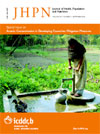
|
The Journal of Health, Population and Nutrition
icddr,b
ISSN: 1606-0997
EISSN: 1606-0997
Vol. 35, No. 1, 2016, pp. 1-14
|
 Bioline Code: hn16035
Bioline Code: hn16035
Full paper language: English
Document type: Research Article
Document available free of charge
|
|
|
The Journal of Health, Population and Nutrition, Vol. 35, No. 1, 2016, pp. 1-14
| en |
Childhood diarrhea in high and low hotspot districts of Amhara Region, northwest Ethiopia: a multilevel modeling
Azage, Muluken; Kumie, Abera; Worku, Alemayehu & Bagtzoglou, Amvrossios C.
Abstract
Background: Childhood diarrhea is one of the major public health problems in Ethiopia. Multiple factors at
different levels contribute to the occurrence of childhood diarrhea. The objective of the study was to identify the
factors affecting childhood diarrhea at individual and community level.
Methods: A cross-sectional study design was employed from February to March 2015 in high and low hotspot
districts of Awi and West and East Gojjam zones in Amhara Region, northwest Ethiopia. Districts with high and low
hotspots with childhood diarrhea were identified using SaTScan spatial statistical analysis. A total of 2495
households from ten (five high and five low hotspot) randomly selected districts were included in the study. A
semi-structured questionnaire was used to collect data. Data were entered and cleaned in Epi Info 3.5.2 version and
analyzed using Stata version 12. A multilevel logistic regression was used to identify factors associated with
childhood diarrhea.
Results: The prevalence of childhood diarrhea was 13.5 % and did not show significant variation between high [14.
3 % (95 % CI 12.3–16.2 %)] and low [12.7 % (95 % CI 10.9–14.6 %)] hotspot districts. Individual- and community-level
factors accounted for 35 % of childhood diarrhea variation across the communities in the full model. Age of
children (6–35 months), complementary feeding initiation below 6 months, inadequate hand washing practices,
limited knowledge of mothers on diarrhea, lowest wealth status of households, and longer time interval to visit
households by health extension workers were factors for increasing the odds of childhood diarrhea at the
individual level. At the community level, lack of improved water supply and sanitation and unvaccinated children
with measles and rotavirus vaccine were the factors associated with childhood diarrhea.
Conclusions: In this study, childhood diarrhea occurrences remained high. Both individual- and community-level
factors determined the occurrence of diarrhea. Interventions should consider both individual- and community-level
factors to reduce the occurrence of childhood diarrhea.
Keywords
Childhood diarrhea; Children; Water; Sanitation; Multilevel analysis; Ethiopia
|
| |
© Copyright 2016 - The Journal of Health, Population and Nutrition
Alternative site location: http://www.jhpn.net
|
|
